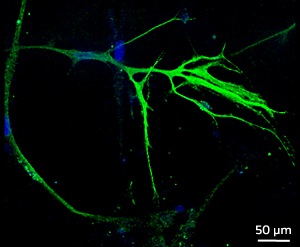
Immunofluorescence image of neuronal protein markers expressed in human mesenchymal stem cells differentiated in gelatin-HPA hydrogels.
© 2010 IBN
Recent advances in tissue engineering have given scientists the ability to produce a variety of cell types from stem cells using artificial growth media. Some scientists, for example, have grown neurons, muscle and bone cells on collagen-coated polyacrylamide gels from human mesenchymal stem cells. The technique holds the promise of growing functional artificial tissue for repairing or replacing damaged human tissue.
Recent experiments have suggested that the stiffness of the hydrogel used as a growth medium may play an important role in the growth and development of stem cells. Motoichi Kurisawa and co-workers at the A*STAR Institute of Bioengineering and Nanotechnology have now developed a biodegradable hydrogel with tunable stiffness for culturing human mesenchymal stem cells. The researchers studied the effects of hydrogel stiffness on stem cell properties and found that it is possible to control stem cell differentiation—the end product or cell type produced from stem cells—by changing the hydrogel stiffness.
The biodegradable hydrogel was made by adding hydrogen peroxide and horseradish peroxidase to a gelatin–hydroxyphenylpropionic acid (HPA) conjugate. The stiffness and gelation rate of the gelatin–HPA hydrogel could be independently controlled by varying the amount of hydrogen peroxide and horseradish peroxidase used, respectively. This allowed the researchers to alter the mechanical strength of the gelatin–HPA hydrogels without changing the polymer precursor solution or affecting its gelation rate over a wide range of stiffness.
Kurisawa and his colleagues cultured human mesenchymal stem cells on two different hydrogels: one as soft as brain tissue (stiffness of 600 pascals) and one as stiff as muscle (12,800 pascals). They found that hydrogel stiffness strongly affected the attachment, focal adhesion, migration and proliferation of human mesenchymal stem cells. On the stiffer gel, the human mesenchymal stem cells had a larger spreading area, more organized cytoskeletons, more stable focal adhesion, faster migration and a higher proliferation rate.
The researchers also found that hydrogel stiffness strongly affected the differentiation of human mesenchymal stem cells. On the softer gel, the stem cells expressed the protein markers of neurons, whereas on the stiffer gel, the stem cells expressed the protein markers of muscle cells.
The findings show that stem cell properties are affected not only by biochemical parameters, but also by physical parameters. A good understanding of how these physical parameters influence stem cell properties is crucial for tissue engineering applications. The hydrogel is also biodegradable, meaning that it could be injected into human wounds to repair damaged tissue.
The A*STAR-affiliated researchers contributing to this research are from the Institute of Bioengineering and Nanotechnology.



